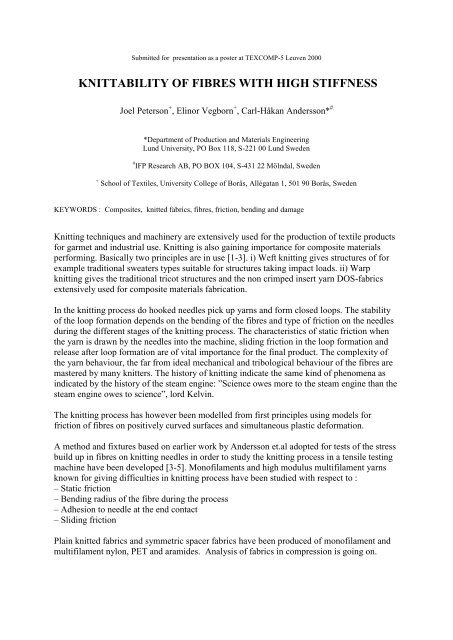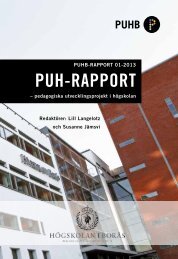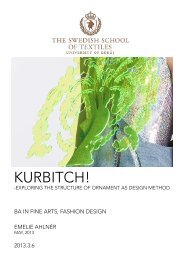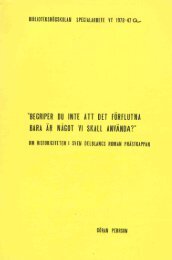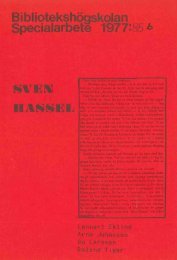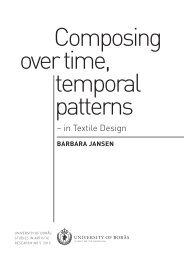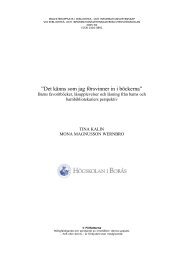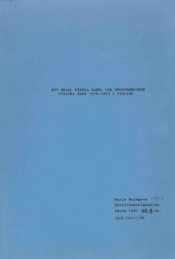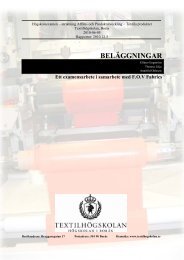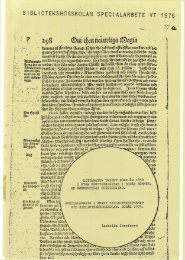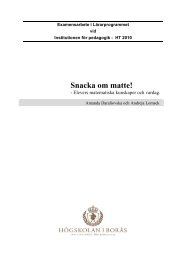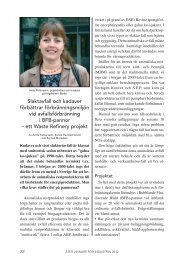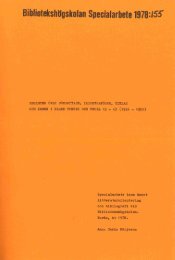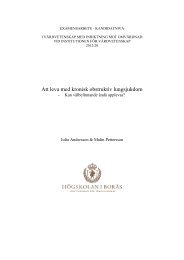knittability of fibres with high stiffness - BADA
knittability of fibres with high stiffness - BADA
knittability of fibres with high stiffness - BADA
You also want an ePaper? Increase the reach of your titles
YUMPU automatically turns print PDFs into web optimized ePapers that Google loves.
Submitted for presentation as a poster at TEXCOMP-5 Leuven 2000<br />
KNITTABILITY OF FIBRES WITH HIGH STIFFNESS<br />
Joel Peterson + , Elinor Vegborn + , Carl-Håkan Andersson* #<br />
*Department <strong>of</strong> Production and Materials Engineering<br />
Lund University, PO Box 118, S-221 00 Lund Sweden<br />
# IFP Research AB, PO BOX 104, S-431 22 Mölndal, Sweden<br />
+ School <strong>of</strong> Textiles, University College <strong>of</strong> Borås, Allégatan 1, 501 90 Borås, Sweden<br />
KEYWORDS : Composites, knitted fabrics, <strong>fibres</strong>, friction, bending and damage<br />
Knitting techniques and machinery are extensively used for the production <strong>of</strong> textile products<br />
for garmet and industrial use. Knitting is also gaining importance for composite materials<br />
performing. Basically two principles are in use [1-3]. i) Weft knitting gives structures <strong>of</strong> for<br />
example traditional sweaters types suitable for structures taking impact loads. ii) Warp<br />
knitting gives the traditional tricot structures and the non crimped insert yarn DOS-fabrics<br />
extensively used for composite materials fabrication.<br />
In the knitting process do hooked needles pick up yarns and form closed loops. The stability<br />
<strong>of</strong> the loop formation depends on the bending <strong>of</strong> the <strong>fibres</strong> and type <strong>of</strong> friction on the needles<br />
during the different stages <strong>of</strong> the knitting process. The characteristics <strong>of</strong> static friction when<br />
the yarn is drawn by the needles into the machine, sliding friction in the loop formation and<br />
release after loop formation are <strong>of</strong> vital importance for the final product. The complexity <strong>of</strong><br />
the yarn behaviour, the far from ideal mechanical and tribological behaviour <strong>of</strong> the <strong>fibres</strong> are<br />
mastered by many knitters. The history <strong>of</strong> knitting indicate the same kind <strong>of</strong> phenomena as<br />
indicated by the history <strong>of</strong> the steam engine: ”Science owes more to the steam engine than the<br />
steam engine owes to science”, lord Kelvin.<br />
The knitting process has however been modelled from first principles using models for<br />
friction <strong>of</strong> <strong>fibres</strong> on positively curved surfaces and simultaneous plastic deformation.<br />
A method and fixtures based on earlier work by Andersson et.al adopted for tests <strong>of</strong> the stress<br />
build up in <strong>fibres</strong> on knitting needles in order to study the knitting process in a tensile testing<br />
machine have been developed [3-5]. Mon<strong>of</strong>ilaments and <strong>high</strong> modulus multifilament yarns<br />
known for giving difficulties in knitting process have been studied <strong>with</strong> respect to :<br />
– Static friction<br />
– Bending radius <strong>of</strong> the fibre during the process<br />
– Adhesion to needle at the end contact<br />
– Sliding friction<br />
Plain knitted fabrics and symmetric spacer fabrics have been produced <strong>of</strong> mon<strong>of</strong>ilament and<br />
multifilament nylon, PET and aramides. Analysis <strong>of</strong> fabrics in compression is going on.
REFERENCES<br />
1. Leong K H, Ramakrishna S, Huang Z M, Bibo G A : The potential <strong>of</strong> knitting for<br />
engineering composites-a review. Composites A 31 (2000) 197-220<br />
2. Stumpf H, Mäder E, Baeten S, Pisanikovski T, Zäh W, Eng K, Andersson C-H,<br />
Verpoest I, Schulte K : New thermoplastic composite preforms based on split-film warp<br />
knitting. Composites 29A, 1511-1523, 1998<br />
3. Andersson C.-H.:Analysis <strong>of</strong> contact stresses due to combined bending and sliding <strong>of</strong> <strong>high</strong><br />
performance <strong>fibres</strong>. Mechanics <strong>of</strong> Composite Materials. 33(1997) 147 - 154<br />
4. Andersson C-H, Nilsson A, Larsson L-G, Christensson B, Wickberg A : Handleability, dust<br />
and damage <strong>of</strong> reinforcement <strong>fibres</strong>. TEXCOMP - 3, Aachen 9 - 11 December 1996, paper 20<br />
5. Andersson C-H : Some notes on friction and testing adhesion and bonding <strong>of</strong> <strong>fibres</strong>.<br />
J.Mater.Sci.Lett. 17 (1998) 1111-1112<br />
6. Mäder E., Grundke K., Jacobasch H.-J., Wachinger G. : Surface, interphase and composite<br />
property relations in fibre reinforced polymers. Composites 25(1994) 739 - 744


